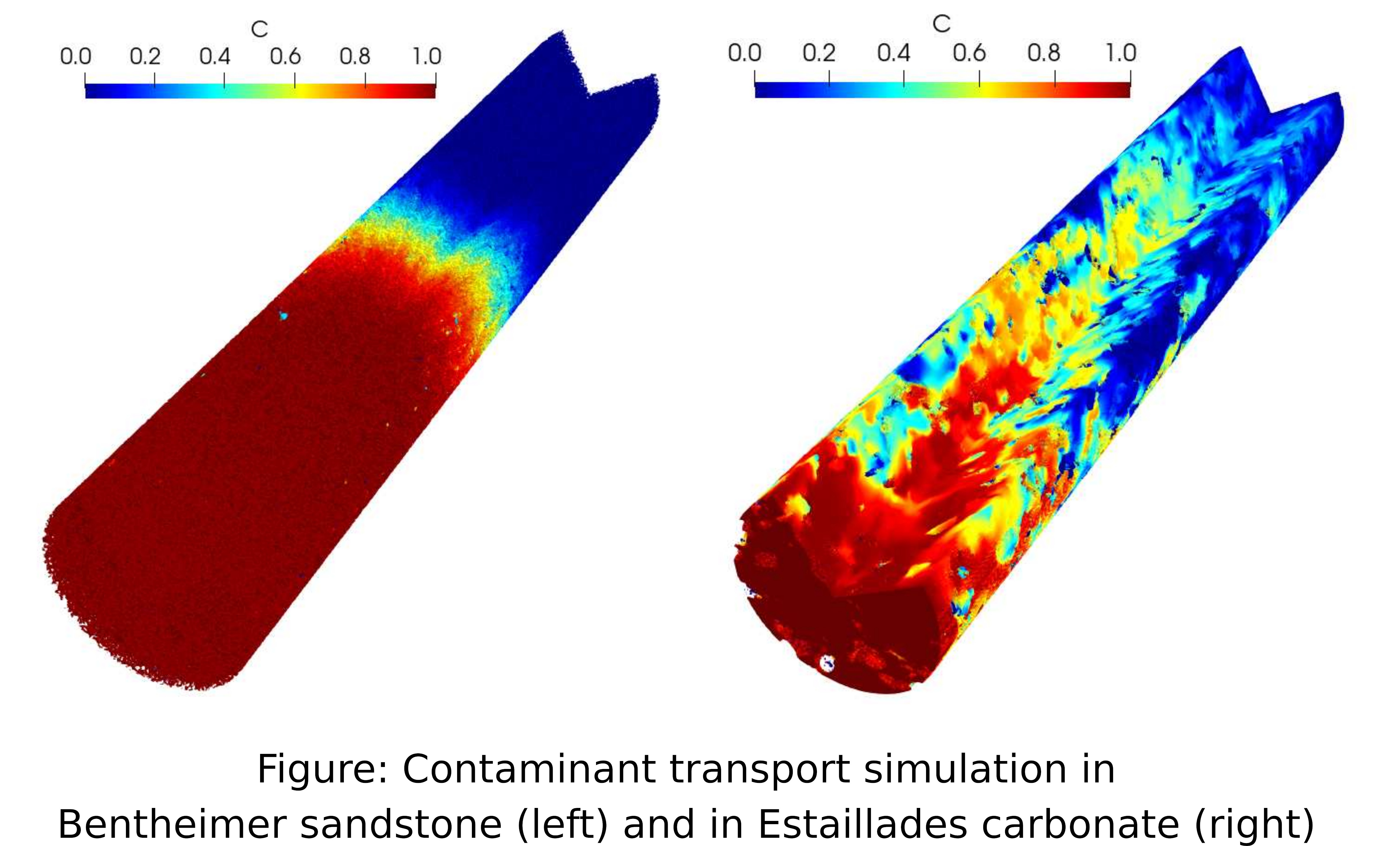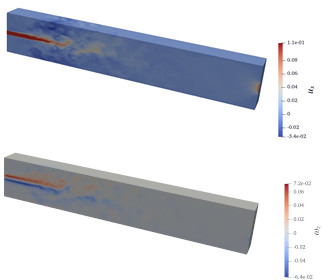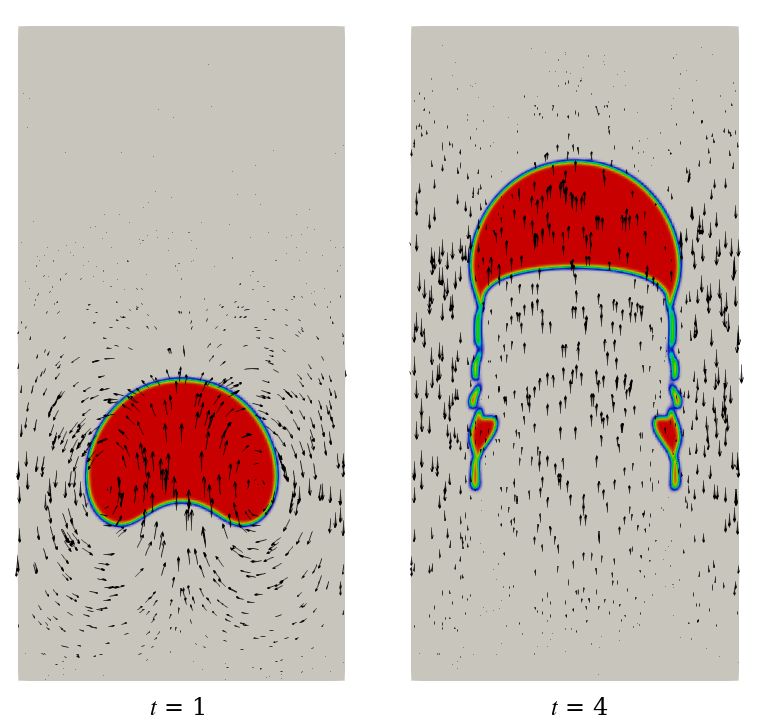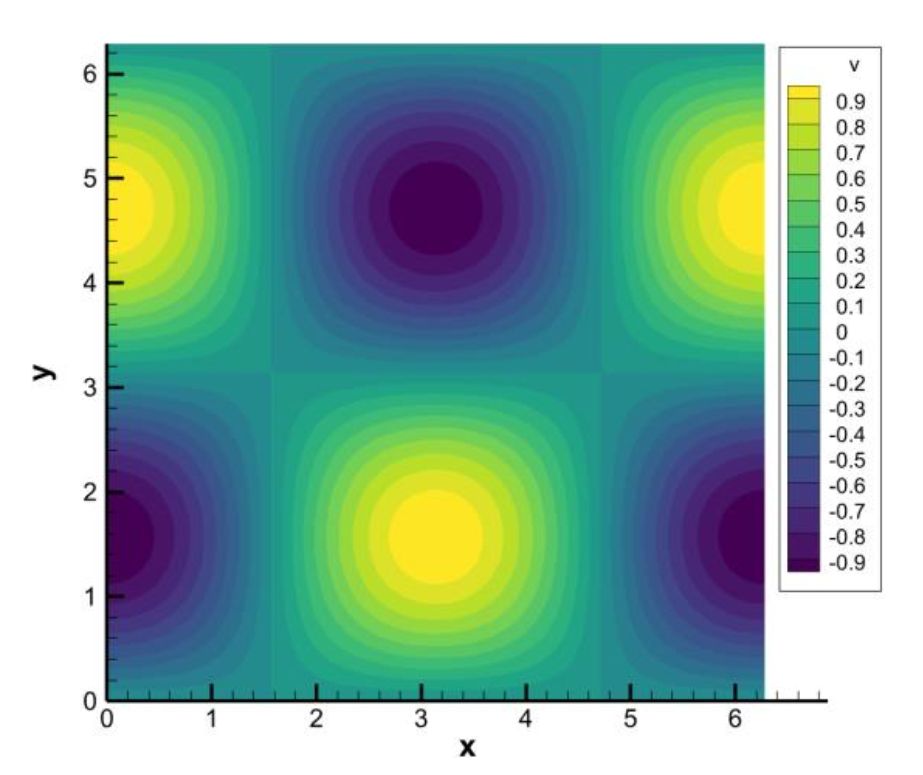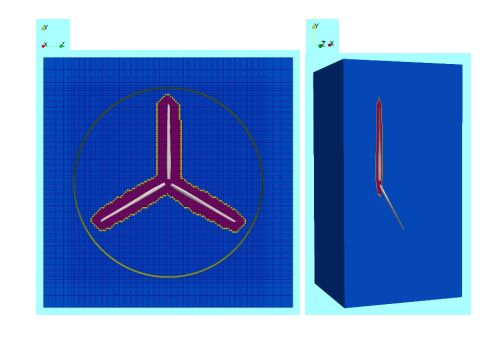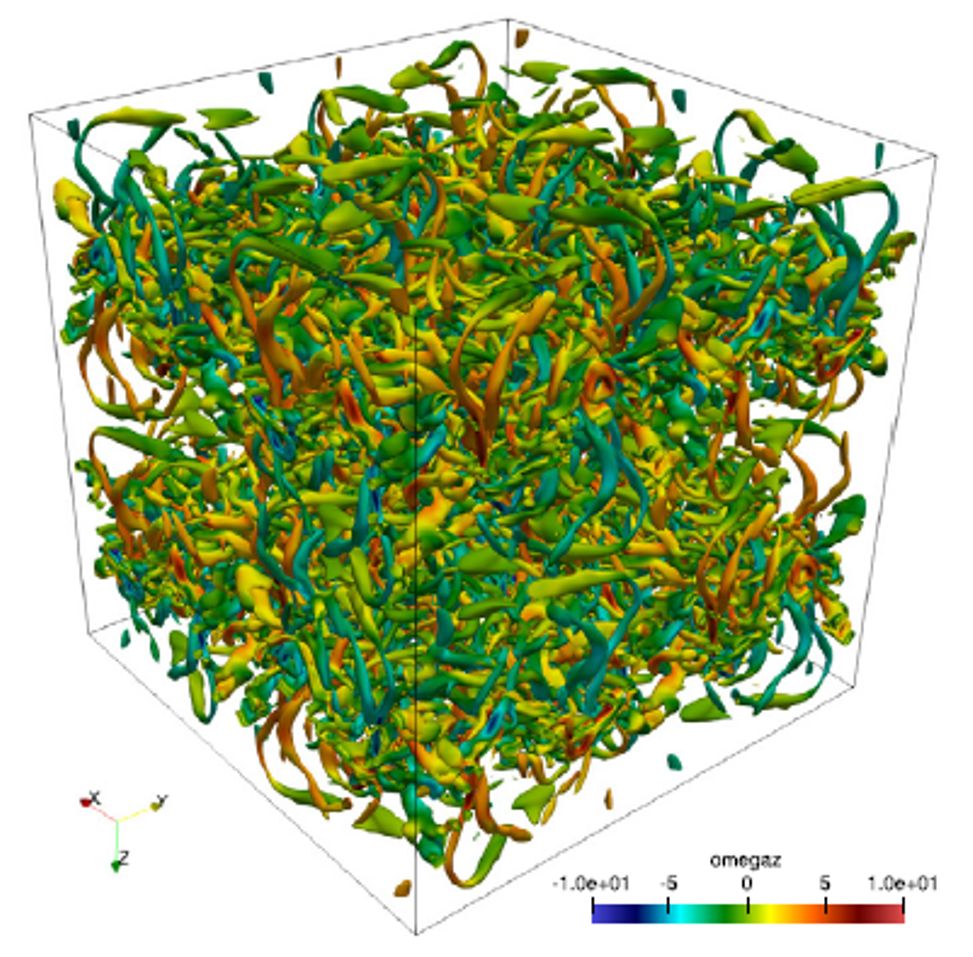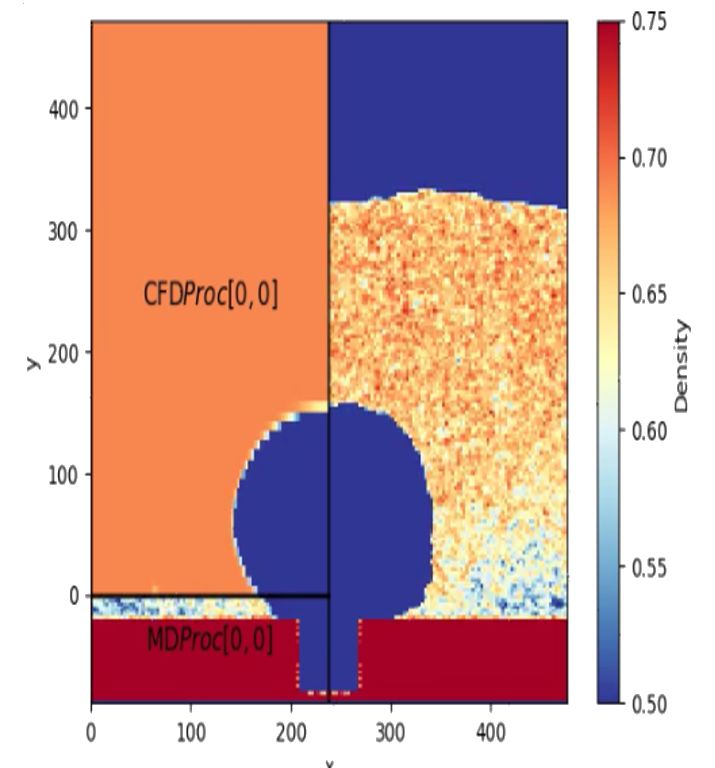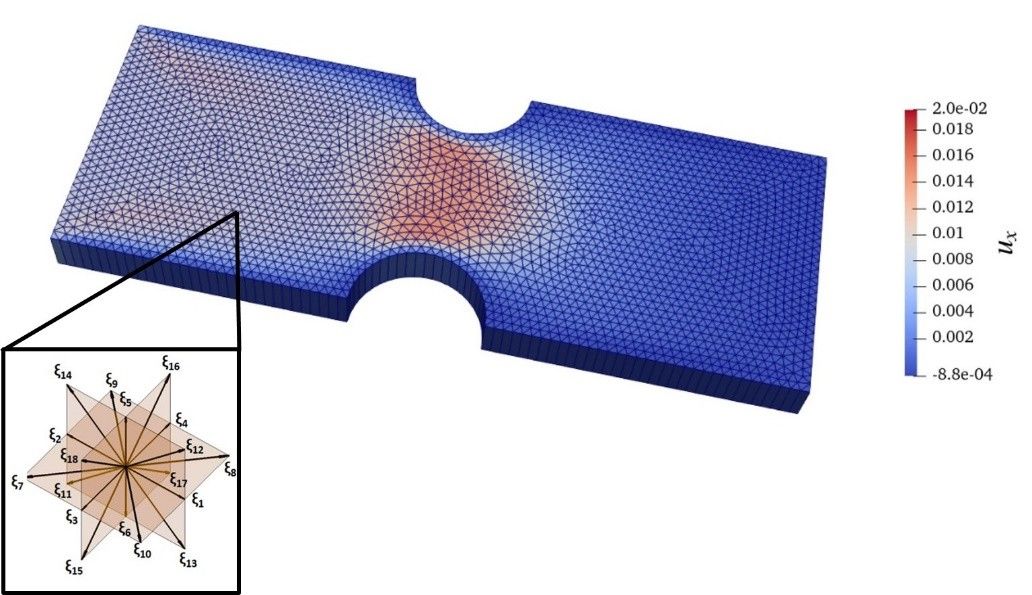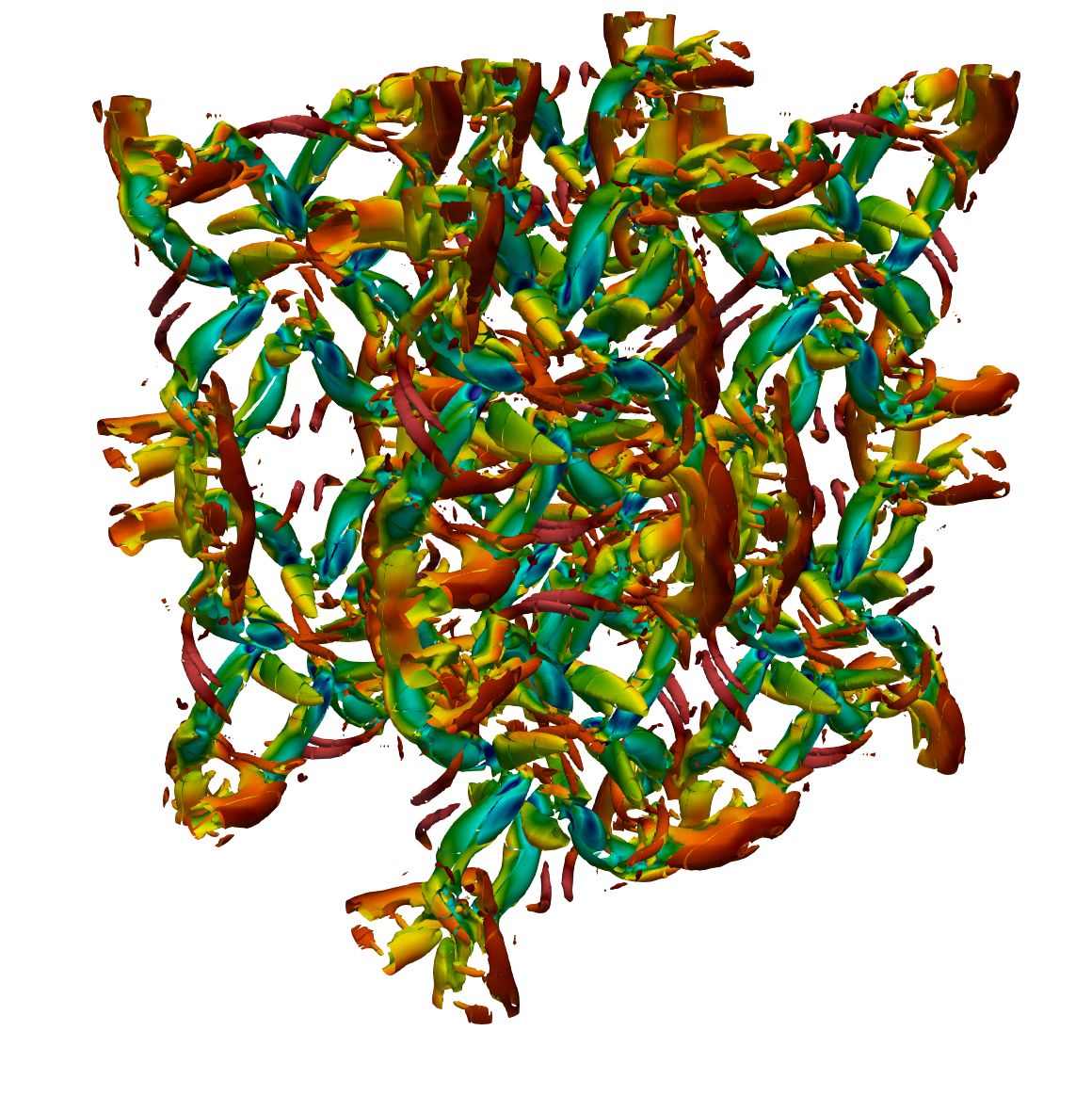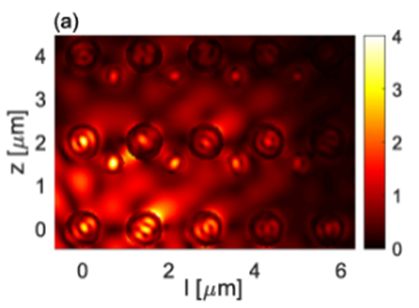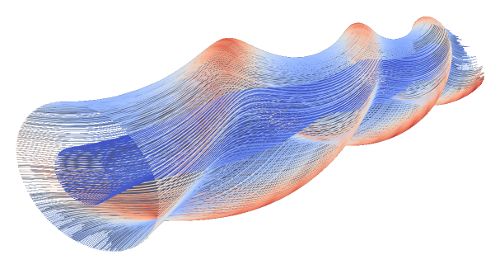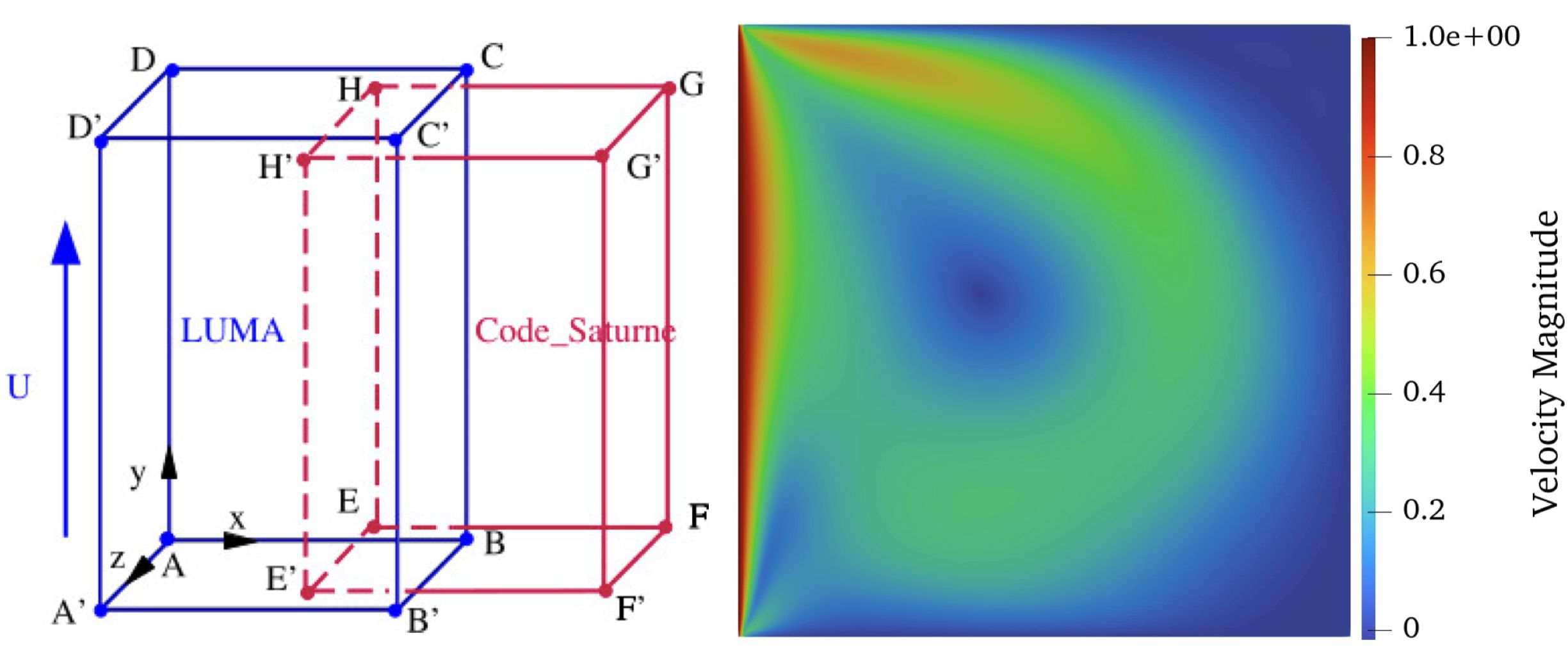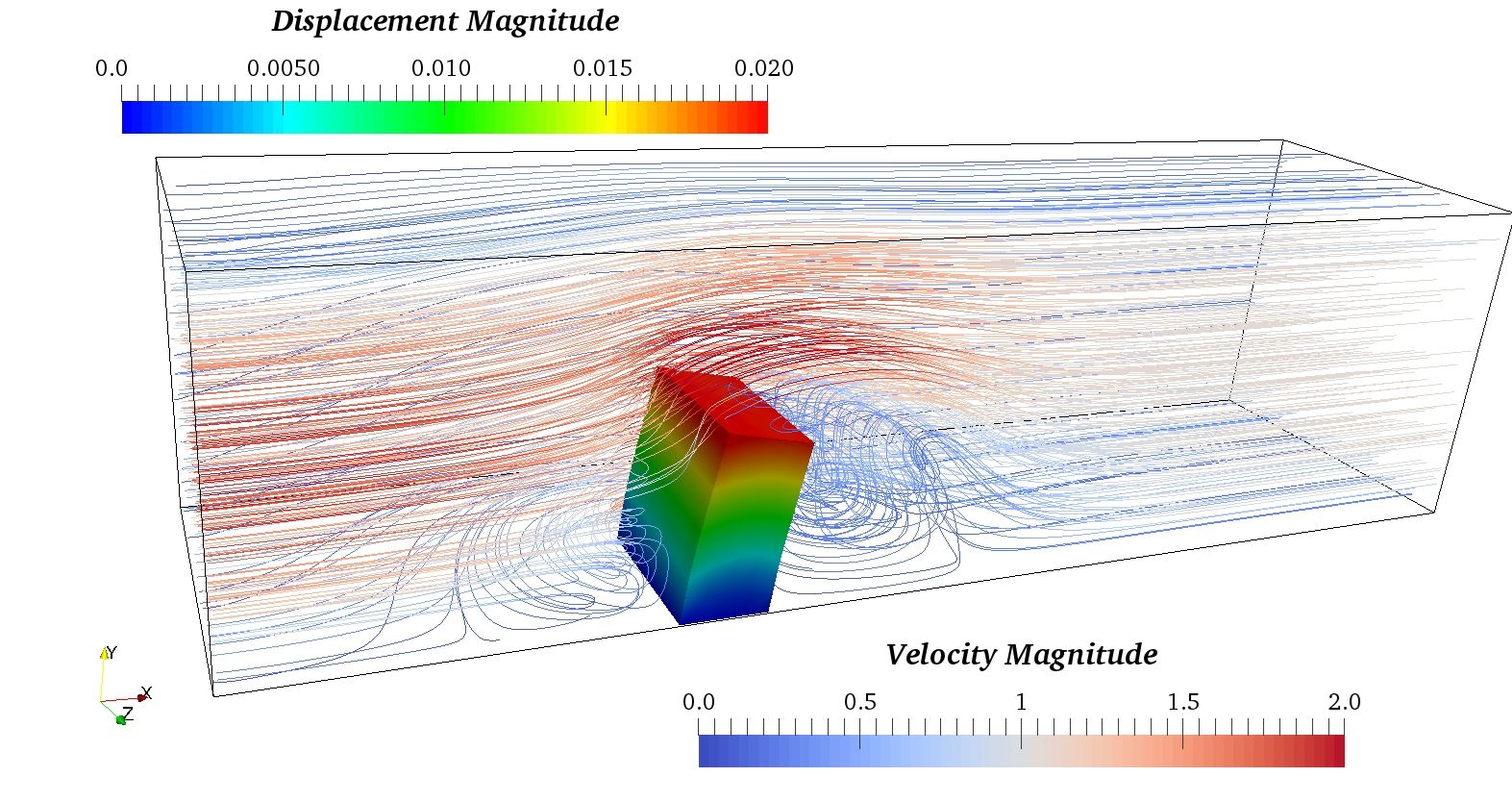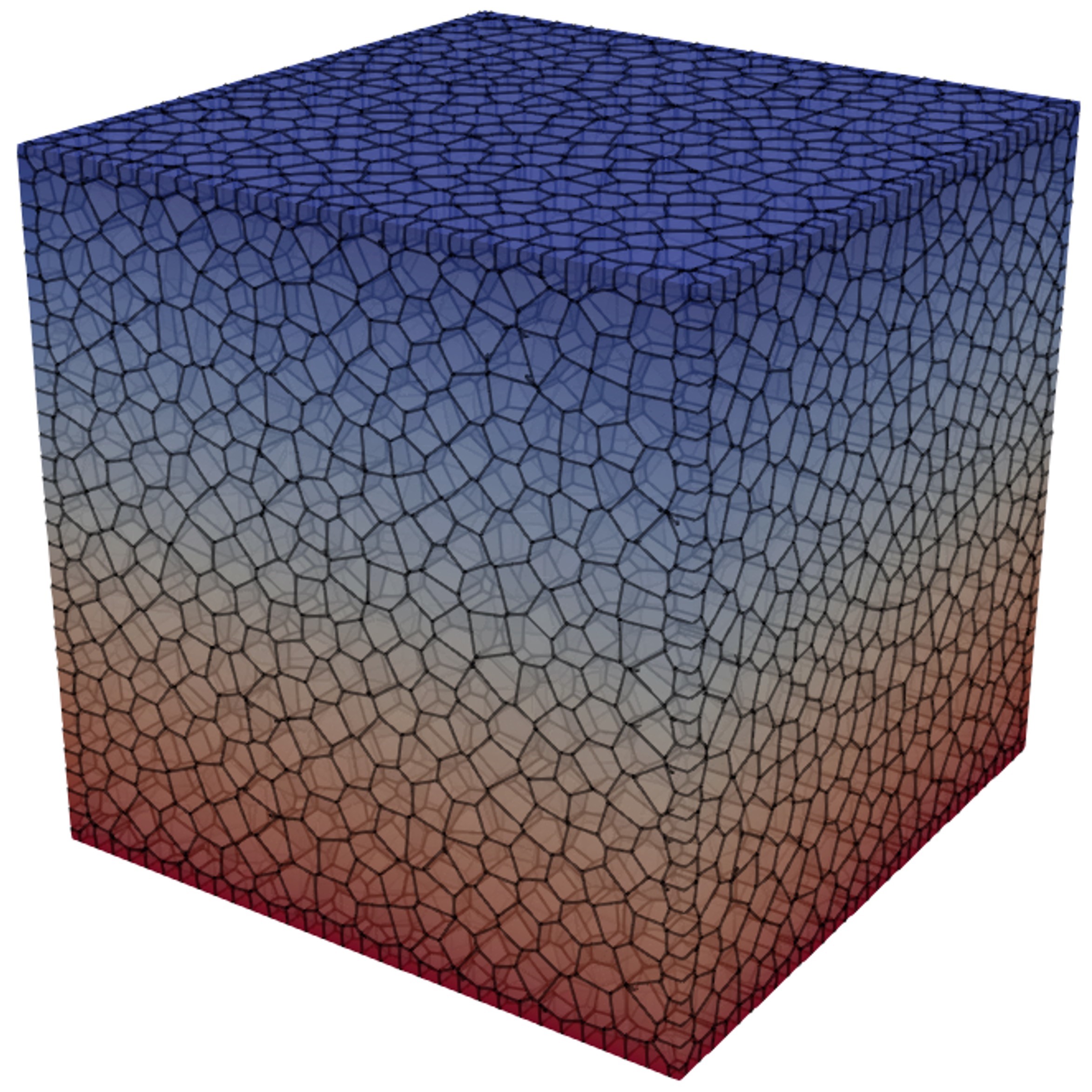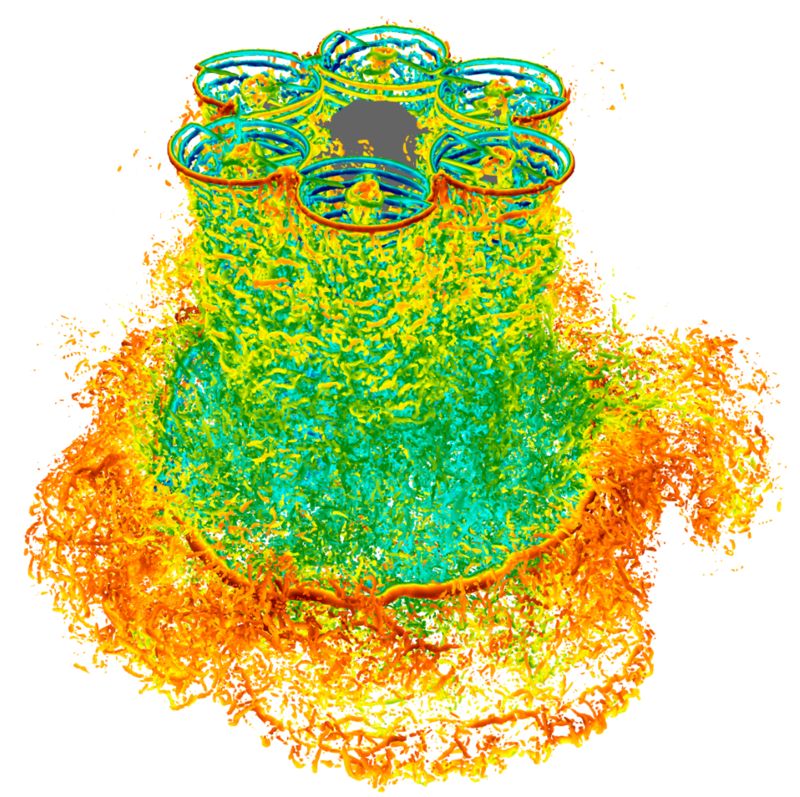Chemistry and Materials Earth Sciences and Environment Engineering and Energy Fundamental physics Mathematics and Computer Science Medicine and Life Sciences All GeoChemFoam – A fully-parallel pore-scale physics numerical solver package for the energy transition
ARCHER2-eCSE10-02 : Dr Hannah Menke (Heriot-Watt University)Subject Area:
Engineering and Energy GeoChemFOAM is the world’s most advanced open source pore-scale numerical simulator, and is based on the widely used Computational Fluid Dynamics code OpenFOAM. GeoChemFOAM is specifically designed for research into pore-scale processes which are vital to the energy sector’s transition from fossil fuels to our Net Zero future. Applications of the code include the design and optimisation of carbon capture and storage, geothermal energy systems, hydrogen fuel cells, building materials, and nuclear waste disposal. The eCSE project carried out work on two parts of the OpenFOAM code, adapting them so that they can now make use of the memory of multiple compute nodes simultaneously. This enables researchers to carry out more complex simulations using larger datasets, allowing more sophisticated research to be carried out not only by GeoChemFOAM users, but by the entire OpenFOAM user community, estimated to number around 10,000 users worldwide. Read more...
Developing a multiscale continuum framework for exascale computing of fluids with microstructure
ARCHER2-eCSE09-10 : Dr Jianping Meng (University of Liverpool)Subject Area:
Engineering and Energy Many natural and industrial processes involve fluids with a microstructure, e.g., landslides, avalanches, blood flows with clots, granular flows for chemical processes, and turbulence modelling. To model such fluids accurately, the evolution of the microstructure must be taken into account. This requires a balance between the computational efficiency of classical continuum methods and the computational accuracy of atom-based methods. This eCSE project developed a new module for code_saturne, a general-purpose computational dynamics software package. This new module, CS-MICRO, extends the modelling capabilities of code_saturne to enable simulation of fluids with a micro-structure by introducing additional degrees of freedom to model implicitly the evolution of the microstructure. Scaling tests performed on ARCHER2 including meshes of 700 million cells indicate that CS-MICRO retains the excellent parallel performance of Code_Saturne. Read more...
Implementing a multiphase flow modelling capability targeting boiling in the high-fidelity software CHAPSim2
ARCHER2-eCSE08-06 : Dr Wei Wang (STFC Daresbury Laboratory)Subject Area:
Engineering and Energy This eCSE project addresses the growing need for high-fidelity simulations of boiling and related multiphase phenomena, which are essential in energy, chemical, and industrial processes. In nuclear reactors, for example, better modelling of boiling can lead to more accurate predictions of critical heat flux, improving safety margins while reducing overly conservative design constraints. This has the potential to lower construction costs and enhance power generation efficiency. Beyond the nuclear sector, understanding bubbly and boiling flows is also important for designing effective systems in chemical and process engineering. As part of this project, a new multiphase model was implemented in CHAPSim2, a direct numerical simulation tool designed for high-accuracy, high-fidelity analysis of turbulence and heat transfer in non-conventional fluids. This new model enables the software to tackle a wider range of scientific and engineering challenges. It will benefit both academic researchers and industrial engineers, providing them with an accurate, robust, and scalable framework for investigating complex multiphase phenomena. Read more...
Implementation of a DNS capability for hypersonic turbulent flows in the high-altitude atmosphere
ARCHER2-eCSE07-08 : Dr Jian Fang (STFC – Daresbury Laboratory)Subject Area:
Engineering and Energy Non-equilibrium gas flows play a crucial role in various technological and scientific fields, including mass spectrometry, vacuum systems, and aerospace engineering. Specific examples include gas flows in micro-electro-mechanical systems, heat transfer for high-altitude vehicles, and gas transport in porous materials used in energy storage and filtration. However, accurately modelling these flows is particularly challenging in hypersonic aerospace applications, where turbulence, shock waves, and rarefaction interact in complex ways. This eCSE project has enhanced ASTR, an open-source high-order Computational Fluid Dynamics code for turbulence and shock research, with new modules that improve the simulation of non-equilibrium gas dynamics. These advancements will not only aid the scientific community in predicting and analysing shock waves and turbulence but also contribute to the development of more efficient space exploration technologies, improved vacuum-based manufacturing processes, and innovations in environmental monitoring, ultimately leading to advancements in energy efficiency and sustainable engineering solutions. Read more...
Evaluating and Optimising the OpenFOAM Overset Mesh Solver for Offshore Renewable Applications
ARCHER2-eCSE07-07 : Prof Ling Qian, Manchester Metropolitan UniversitySubject Area:
Engineering and Energy Offshore renewable energy structures in the marine environment operate in harsh and inconsistent conditions. The design process for these structures must be robust, and involves extensive numerical and experimental testing. An accurate and efficient Computational Fluid Dynamics (CFD) model is needed in order to capture the complex hydrodynamics and aerodynamics. The overset method for CFD models is particularly well suited to the task, but it can be computationally expensive and inefficient. This eCSE project developed a new optimised version of the open-source ESI-OpenCFD OpenFOAM overset mesh solver. In both test cases used, the computational time was reduced, and in one of the cases the model ran three times faster than before. Additionally, the new method was shown to be more efficient, running faster even when using half the number of computational nodes as before. Read more...
Extending the capabilities of the DNS code Xcompact3D by incorporating Magnetohydrodynamics (MHD), for large scale turbulent flows on ARCHER2
ARCHER2-eCSE07-03 : Dr Alex S Skillen (University of Manchester)Subject Area:
Engineering and Energy This work involved the development of a high-performance Magnetohydrodynamics (MHD) module integrated into the Xcompact3d framework, an open-source computational fluid dynamics (CFD) solver designed to study turbulent flows on supercomputers. MHD is the study of the dynamics of fluid flows coupled with electromagnetic fields, with applications ranging from plasma physics and nuclear fusion to astrophysics and geophysics. Accurately simulating MHD flows is a challenging task due to the complex interactions between the fluid and magnetic fields. The new MHD module in Xcompact3d provides a powerful tool for researchers to gain deeper insights into MHD phenomena, which can lead to advancements in areas like fusion reactor design, space weather modelling, and our understanding of the Earth's magnetic field. Read more...
Hybrid Atomistic-Continuum Simulations of Boiling Across Scales
ARCHER2-eCSE06-01 : Dr Mirco Magnini (University of Nottingham)Subject Area:
Engineering and Energy The next generation of science depends on solving the problem of linking simulations at different scales. In many physical processes, phenomena happening at the molecular scale determine the large-scale dynamics of the system. Boiling represents one such problem, where bubbles nucleating at the nanoscale depart from hot surfaces, owing to fluid dynamics forces originating from millimetre-scale flow structures. Unravelling the multiscale interplay of physical processes in boiling phenomena would enable more robust thermal design principles and optimisation of next-generation heat exchangers, for use in thermal management of components in renewable energy conversion systems, such as cooling of nuclear reactors and battery packs for electric vehicles. This project extended an existing coupling library (www.cpl-library.org) and optimised it for parallel computing, delivering a coupling platform for two popular open-source simulation toolboxes (LAMMPS for Molecular Dynamics and OpenFOAM for continuum-scale Computational Fluids Dynamics). Although this project focused on fluid mechanics multiscale coupling to simulate boiling from bubble nucleation to departure, the software platform enables easy extension to any other physics. Read more...
Implementation of the Discrete Unified Gas Kinetic Scheme in Code_Saturne targeting Exascale
ARCHER2-eCSE05-09 : Dr Jianping Meng (STFC – Daresbury Laboratory, now University of Liverpool)Subject Area:
Engineering and Energy The successful transition to net-zero greenhouse emissions will rely significantly on clean-energy pathway technologies, i.e., solar energy, hydrogen fuel cells and CO2 storage. To better develop these technologies, we need to understand many flow processes happening at the mesoscale, e.g., micro gas flows in hydrogen fuel cells. This requires the development of mesoscopic codes, suitable for industrial level applications and targeted towards exascale computers. This project aimed to develop the mesoscale modelling capability of Code_Saturne, an open-source, pre-exascale-ready Computational Fluid Dynamics code. A new module was implemented in the code – the discrete unified gas kinetic scheme (DUGKS). This numerically solves the mesoscale Boltzmann equation using a Finite Volume discretisation in the physical space and a discretised molecular velocity space. The scheme is applicable for a wide range of fluid flows and beyond, e.g., phonon heat transfer and plasma. Read more...
Developing in-situ analysis capabilities for pre-Exascale simulations with Xcompact3D
ARCHER2-eCSE03-02 : Dr Sylvain Laizet (Imperial College London)Subject Area:
Engineering and Energy Many of the environmental and energy-related issues we face today cannot possibly be tackled without a better understanding of the dynamics of fluids. The design of many engineering and industrial systems as well as the prediction of their impact on the environment greatly relies on the turbulent behaviour of fluid flows being properly quantified. Significant progress has been made recently using high performance computing, and Computational Fluid Dynamics is now a critical complement to experiments and theories. Xcompact3D is a high-order CFD framework designed for simulating turbulent flows on supercomputers, with applications ranging from fundamental turbulence studies to simulating and optimising wind farm designs. As computational power has increased, the rate at which data can be stored has not kept pace with the rate at which it can be generated, leading to the so-called “I/O bottleneck”. To address this in Xcompact3D, this project has implemented a new I/O system using the ADIOS2 library to facilitate user-defined in situ analyses. Read more...
Massively parallel and scalable electromagnetic solver for fast analysis of nonlinear optical processes in large clusters of nanoparticles
ARCHER2-eCSE02-12 : Prof Nicolae C. Panoiu (University College London)Subject Area:
Engineering and Energy OPTIMET-3D is a numerical electromagnetic (EM) solver for analysis of EM wave scattering from clusters of nanoparticles embedded in a homogeneous medium. This project introduced powerful new functionalities to OPTIMET, including the ability to handle some of the most common non-spherical particle morphologies encountered in nanotechnology applications, such as ellipsoids, cylinders and spheroids. Further, the number of particles that OPTIMET can now handle is at least an order of magnitude larger than it was previously, and it can now analyse clusters of nanoparticles many orders of magnitude faster than commercial solvers, which are based on the finite element method. OPTIMET is believed to be the first code adapted specially for the fast and accurate analysis of linear and nonlinear second harmonic (SH) optical phenomena pertaining to systems of very large number of particles. The addition of the new module has substantially expanded the scientific areas which can benefit from OPTIMET, as the SH interactions phenomenon lies at the heart of many applications, including optical sensors, plasmonic nanoantennae, photonic and plasmonic crystals, metamaterials and wavelength converters. Read more...
Optimizing BOUT++ MPI+OpenMP hybrid performance by refactoring compute kernels
ARCHER2-eCSE02-11 : Dr Joseph Parker (United Kingdom Atomic Energy Authority)Subject Area:
Engineering and Energy For 70 years, humans have been pursuing nuclear fusion as a clean, safe and near limitless source of energy production. Major experimental nuclear fusion reactors (“tokamaks”) already exist, and planning for demonstration power plants is now well underway. BOUT++ is a software framework for simulating the plasma inside a tokamak. It is designed to be both performant and easy-to-use, and can run across a range of computers, from laptops to national computing facilities like ARCHER2. However, to run on the world’s largest supercomputers, BOUT++ needs to further exploit parallelism – the ability to solve many interlinked components of a problem concurrently. This eCSE project improved the parallel efficiency of the BOUT++ code. Users can now produce higher-fidelity simulations of tokamaks, thereby increasing our understanding of critical plasma physics processes. Currently tractable simulations can be run in a shorter time, and larger ensembles of simulations can be run. This is crucial for enabling faster parameter scans and performing uncertainty quantification (UQ), a technique that is becoming increasingly important for assessing the robustness of physics results. Read more...
Multi-Resolution Coupling for Exascale Engineering
ARCHER2-eCSE01-28 : Prof Alistair Revell (University of Manchester)Subject Area:
Engineering and Energy Motivation for so-called multi-scale modelling is all around us in the everyday world, where small changes at a very small scale can impact on large, system-level, engineering processes, e.g. the impact of surface degradation on the performance of a heat exchanger, or the clogging up of porous surfaces over time. The ability for computational science to bridge scales from both macro- and microscale physics to mesoscale modelling is likely to benefit a broad range of computational scientists and engineers. This project has provided two fully functional examples of coupling between popular computational macro- and microscale simulation tools (Code_Saturne and LAMMPS respectively) and the mesoscale LUMA Lattice Boltzmann code. The work lays a solid foundation for future multi-scale simulations for industrial engineering applications. Read more...
A Partitioned Fluid-Structure Interaction Framework for Exascale
ARCHER2-eCSE01-22 : Dr Alex S Skillen (University of Manchester)Subject Area:
Engineering and Energy Fluid-structure interaction (FSI) occurs frequently in the field of renewable and low-carbon energy generation. Simulation of FSI problems is highly computationally demanding. This project developed an efficient and highly scalable FSI simulation tool, ParaSiF_CF, which can be used for a wide range of simulation cases, including extremely large problems involving “typical” operating conditions in the fields of offshore wind, marine turbines and nuclear energy, and the simulation of plastic polymer or composite material components that are involved in offshore turbines. Read more...
ParaGEMS: Integrating discrete exterior calculus (DEC) into ParaFEM for geometric analysis of solid mechanics
ARCHER2-eCSE01-12 : Prof Lee Margetts (University of Manchester)Subject Area:
Engineering and Energy This project integrated the geometric and topological functions of the new discrete exterior calculus (DEC) library ParaGEMS into ParaFEM, a well-established open-source finite-element library. A series of five MiniApps was developed and optimised to model elasticity and diffusion on synthetic material micro-structures with existing or emerging heterogeneities and discontinuities. The outputs of the project will support new innovations promised by the recently funded UK Collaborative Computational Project on wave-structure interaction (CCP-WSI+), which brings together cutting-edge research in both fluids and computational solid mechanics to advance research into offshore energy generation. Read more...
High fidelity simulations of moving objects in a turbulent flow using a Cartesian mesh
ARCHER2-eCSE01-06 : Dr Sylvain Laizet (Imperial College London)Subject Area:
Engineering and Energy Developing accurate, efficient and scalable tools to simulate arbitrarily complex moving geometries in turbulent flows remains a considerable challenge in Computational Fluid Dynamics (CFD). Fluid-Structure Interaction (FSI) problems, where one or more complex solid structures interact and modify the behaviour of the surrounding fluid, pose an even greater challenge. FSIs are commonly found in nature and in many engineering fields such as energy (fixed and floating wind turbines, wave energy converters) and biomedical engineering (e.g. heart valves). In this project, new capabilities have been implemented in the high-order finite-difference framework Xcompact3d, and a Computer-Aided Design (CAD) interface has been developed, to facilitate high-fidelity simulations of incompressible turbulent flows. Read more...

